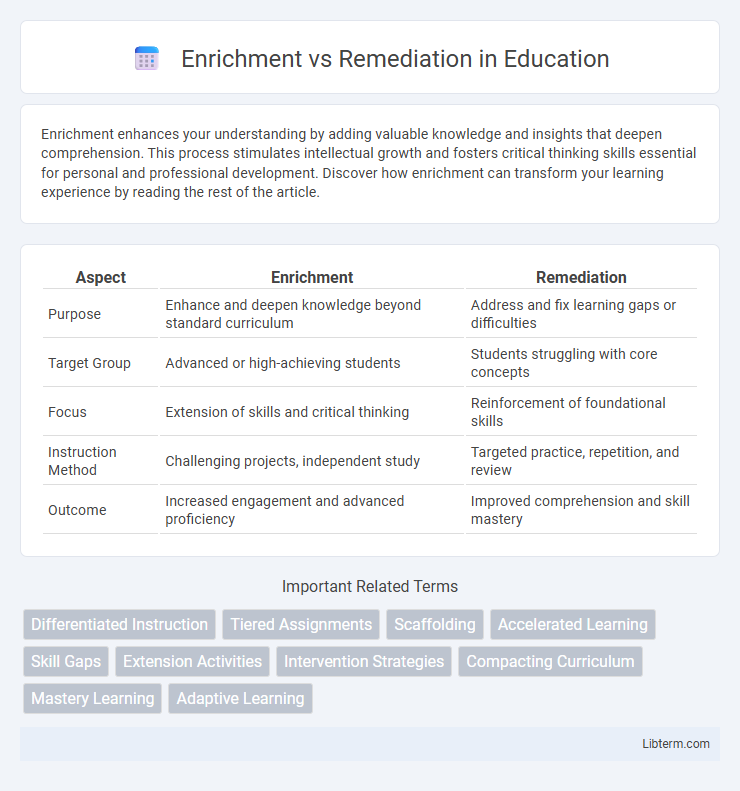Enrichment enhances your understanding by adding valuable knowledge and insights that deepen comprehension. This process stimulates intellectual growth and fosters critical thinking skills essential for personal and professional development. Discover how enrichment can transform your learning experience by reading the rest of the article.
Table of Comparison
| Aspect | Enrichment | Remediation |
|---|---|---|
| Purpose | Enhance and deepen knowledge beyond standard curriculum | Address and fix learning gaps or difficulties |
| Target Group | Advanced or high-achieving students | Students struggling with core concepts |
| Focus | Extension of skills and critical thinking | Reinforcement of foundational skills |
| Instruction Method | Challenging projects, independent study | Targeted practice, repetition, and review |
| Outcome | Increased engagement and advanced proficiency | Improved comprehension and skill mastery |
Understanding Enrichment and Remediation
Enrichment involves providing students with advanced, challenging content that extends their learning beyond the standard curriculum, targeting higher-order thinking skills and creativity. Remediation focuses on identifying and addressing specific learning gaps to help students achieve grade-level proficiency through targeted instruction and practice. Both strategies aim to personalize education but differ in goals: enrichment accelerates learning for mastery and exploration, while remediation ensures foundational skills are solidified for academic success.
Key Differences Between Enrichment and Remediation
Enrichment focuses on extending and deepening existing knowledge by providing advanced, challenging activities that promote critical thinking and creativity. Remediation targets addressing and correcting specific learning gaps or deficiencies through targeted instruction and practice to bring students up to grade-level proficiency. Key differences include enrichment's role in advancing mastery and engagement versus remediation's emphasis on foundational skill recovery and reinforcing basic concepts.
Goals and Objectives of Each Approach
Enrichment aims to extend learning by providing challenging activities that promote critical thinking, creativity, and deep understanding beyond standard curriculum goals. Remediation focuses on identifying and addressing specific skill gaps or learning deficiencies to ensure students meet foundational academic standards and objectives. While enrichment targets acceleration and broadening knowledge, remediation targets mastery and foundational competency development.
Identifying Students’ Needs: Assessment Strategies
Effective assessment strategies for identifying students' needs involve using formative assessments, diagnostic tests, and observational data to distinguish between those requiring enrichment and those needing remediation. Enrichment assessment emphasizes recognizing advanced comprehension and critical thinking skills, while remediation focuses on pinpointing specific learning gaps and misconceptions. Utilizing data-driven insights from multiple assessment tools ensures tailored instruction that addresses individual student progress accurately.
Benefits of Enrichment in Education
Enrichment in education enhances student engagement by providing advanced, challenging materials tailored to individual interests and strengths, promoting critical thinking and creativity. It fosters a deeper understanding of subjects beyond standard curriculum, encouraging lifelong learning and intellectual curiosity. Enrichment also supports differentiated instruction, allowing gifted and high-achieving students to excel without being held back by remediation-focused approaches.
Importance of Remediation for Struggling Learners
Remediation is critical for struggling learners as it targets specific gaps in foundational skills, enabling them to achieve grade-level proficiency and build confidence in their academic abilities. Effective remediation uses focused, individualized instruction to address diverse learning needs, preventing long-term educational deficits and reducing achievement gaps. Supporting struggling students through remediation fosters engagement and promotes equitable outcomes in the education system.
Effective Techniques for Delivering Enrichment
Effective techniques for delivering enrichment include project-based learning, which encourages critical thinking and real-world application, and differentiation, tailoring activities to meet individual student strengths and interests. Incorporating technology through adaptive learning platforms enhances engagement and allows for personalized pacing. Providing opportunities for creative exploration and interdisciplinary connections fosters deeper understanding and motivation beyond the standard curriculum.
Proven Strategies for Successful Remediation
Effective remediation strategies focus on targeted interventions that address specific learning gaps through personalized instruction and ongoing progress monitoring. Utilizing formative assessments and data-driven techniques allows educators to tailor support, ensuring students master foundational skills before advancing. Structured programs incorporating scaffolding and multi-sensory approaches demonstrate consistent success in improving academic outcomes during remediation.
Integrating Enrichment and Remediation in the Classroom
Integrating enrichment and remediation in the classroom enhances personalized learning by addressing diverse student needs through targeted interventions and advanced challenges. Effective strategies involve using formative assessments to identify skill gaps and extend learning opportunities, fostering both mastery and critical thinking. Combining enrichment and remediation supports differentiated instruction, promotes student engagement, and improves overall academic outcomes.
Measuring the Impact of Enrichment and Remediation
Measuring the impact of enrichment and remediation involves assessing student growth through formative and summative evaluations tailored to individual learning goals. Enrichment programs are often measured by improvements in critical thinking, creativity, and advanced content mastery, while remediation focuses on closing skill gaps and boosting foundational competencies, reflected in standardized test scores and targeted assessments. Data-driven analysis and progress monitoring tools provide educators with insights to refine instruction and maximize learning outcomes for diverse student needs.
Enrichment Infographic

 libterm.com
libterm.com